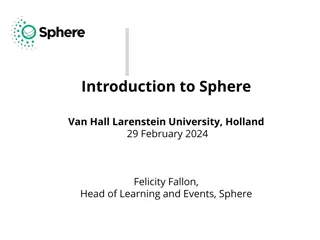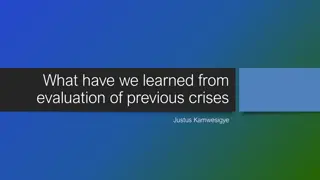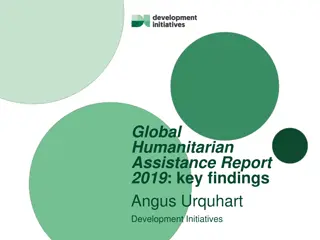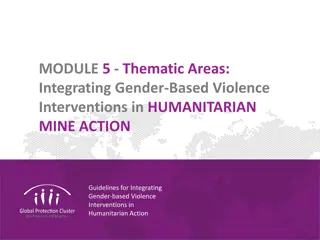Comprehensive Guide to Assessing and Prioritizing Child and Adolescent Health in Humanitarian Settings
This module provides a detailed operational guide on assessing and prioritizing child and adolescent health in humanitarian settings. It covers obtaining data on child/adolescent health, coordinating responses, planning activities, and utilizing data systems for monitoring and evaluation. Key components include needs assessment, coordination, response planning, and monitoring and review. The content emphasizes the complex nature of humanitarian emergencies and outlines principles for conducting effective needs assessments.
Download Presentation

Please find below an Image/Link to download the presentation.
The content on the website is provided AS IS for your information and personal use only. It may not be sold, licensed, or shared on other websites without obtaining consent from the author. Download presentation by click this link. If you encounter any issues during the download, it is possible that the publisher has removed the file from their server.
E N D
Presentation Transcript
Child and adolescent health in humanitarian settings: operational guide 2
The four interconnected programmatic action areas of the operational guide ASSESS & PRIORITISE How to obtain data on child/adolescent health (via needs assessment) and use it to prioritize actions COORDINATE How to take a coordinated approach to child and adolescent health in a humanitarian emergency RESPOND How to plan and enact a coordinated set of activities addressing the identified child and adolescent health priorities MONITOR, EVALUATE & REVIEW How to use data systems to review and improve child and adolescent health- related activities 3
1. Include child and adolescent health in initial health assessment 6
Humanitarian program cycle Humanitarian emergencies are complex and chaotic Key agencies should initiate a coordinated needs assessment at the start of a humanitarian emergency, including: Assess how the situation may evolve Identify gaps in response Assess operational constraints 7
Components of a needs assessment Careful, coordinated assessment of the situation and ongoing monitoring of the response and changing needs is critical to effective humanitarian action Needs assessment should consider: - Crisis impact Scope and scale crisis Conditions affected population - Operational environment Capacities and response Humanitarian access 8
Ten principles for conducting needs assessments 1. National leadership: Promote national and local government leadership in assessments for ownership 2. Preparedness planning: Incorporate assessments into emergency preparedness plans 3. Data utilization: Build assessments on existing CAH data, e.g. national demographic surveys and prior emergency response reports 4. Alignment with monitoring: Ensure a link between assessments and ongoing monitoring efforts 5. Data relevance: Collect data directly relevant to decision-making 6. Inclusive approach: Involve all stakeholders, utilizing technology, including social media, to engage with young people 7. At-risk groups: Address priority needs and groups, such as gender, age, disability, unaccompanied minors, and ethnic minorities 8. Information management: Implement effective information management strategies 9. Context analysis: Include an analysis of the overall context 10.Long-term perspective: Conduct assessments with an eye toward future recovery and development activities 9
Coordinated assessment and phases in humanitarian crisis IASC operational guidance The rapid health assessment will address: - Health status and risks - Health resources and service availability - Health system performance (including coverage, quality, access and utilization) HeRAM: Health Resources Availability Monitorining System EWARS: Early Warning, Alert, and Response System PNDA: Post Disaster Needs Assessment 10
Role of the RMNCAH/CAH working group and individual agencies in the assessment stage Integration broader needs assessment activities integrate child and adolescent needs within broader assessments Active participation ensure that children and adolescents are counted and assessed accurately Age disaggregation including newborns, < 5 years, 5 9 years, 10 14 years, and 15 19 years 11
Specific CAH vulnerabilities and risks Undocumented migrants, unaccompanied and separated children Children and adolescents from ethnic or religious minority populations Children and adolescents with disability or chronic health conditions Young children (<5 years old) Girls Children and adolescents in the armed forces (and ex- combatants) or justice system Children and adolescents in forced or exploitative labour, including sex work Child and adolescent survivors of physical, sexual and emotional abuse Child and adolescent caregivers or primary income earners 12
Issues to consider for children at risk Violence, trauma Food insecurity, undernutrition Disease outbreaks Uncontrolled endemic disease Mental health and psychological well-being Gender Age 13
Data collection method Comments Common data collection tools for humanitarian emergencies IASC Multi-sector initial rapid assessment (MIRA) tool (26) MIRA is the coordinated approach to overall assessment of a crisis situation, and is led by OCHA. It includes the rapid health assessment which is led by the health cluster. HeRAMS is a tool for initial assessment and ongoing monitoring of human resources for health, and is used by the health cluster. SARA is an alternative tool for cross-sectional assessment of health service availability and readiness. WHO Health Resources Availability Monitoring System (HeRAMS) (27) WHO service availability and readiness assessment (SARA) (28) WHO rapid risk assessment (29) Rapid risk assessment guides the initial rapid assessment of acute public health events. EWARS is a system for early detection of crises. (See also action area 3 Monitor, Evaluate, Review) WHO Early Warning and Response System (EWARS) (30) 3W/4W/5W (31) This tool assesses humanitarian response: who, what, when, where, and for whom. The WHO strategic tool for assessing risk is mainly used for planning (preparedness). SMART is a method for rapid assessment of nutrition in emergencies. WHO strategic tool for assessing risk (32) SMART nutrition assessment (33) 14
Key actions needs assessment (1/2) Review data - Members of the RNMCAH/CAH working group review the OCHA risk profile, all hazards response plans and other relevant information sources Context assessment: Contribute to a systematic, objective, and ongoing assessment of the context and stakeholders (intersectoral) - The RMNCAH/CAH working group coordinates input - Advocate for disaggregation of data by sex and age - Use pre-existing data as much as possible For more details, please refer to the operational guide 15
Key actions needs assessment (2/2) Assess safety and security - Focusing on children and young people, to identify threats, violence and human rights violations - Consider using the child protection rapid assessment toolkit Consider gender impact - Consider gender roles/norms/stereotypes affecting children s and adolescent s experience of and response to a crisis Share findings widely - Use multiple communication channels and share with affected populations as well 16
Key indicator needs assessment The health sector lead agency has conducted an initial rapid assessment, with active involvement of the RMNCAH/CAH working group. 17
Rapid assessment of health needs and response capacity The rapid assessment offers a preliminary understanding of needs and response capacity To gain a more comprehensive view, the health cluster and RMNCAH/CAH working group should conduct an in-depth assessment of health service resources and capacity 19
Key actions health service assessment (1/2) Coordinate CAH assessment The RMNCAH/CAH working group coordinates additional CAH assessment in collaboration with the health cluster lead and information management group Review policies and protocols - Avoid duplication and conflicting recommendations with existing programs and protocols - Facilitate government-NGO communication through UN if necessary Update CAH guidelines and tools - Review and update CAH clinical guidelines, health promotion materials, and training tools - Collaborate with government, UN agencies, and NGOs when creating new resources 20
Key actions health service assessment (2/2) Health facility assessment - Map existing facilities, assess capacity, CAH services, and damage by using HeRAMS, SARA, 3W/4W, or field tools Evaluate staffing and competency in all essential CAH services and document the number and type of skilled health providers and facilities Access medicines and supplies: review essential medicines and procurement procedures Create service map for coordination and decision-making and share it with decision-makers, partners and the community For more details, please refer to the operational guide 21
Key indicators health service assessment The RMNCAH/CAH working group has prepared a plan (with the health cluster lead) to conduct additional assessments of CAH needs and response capacity. The plan includes a timeline of activities and designates responsibility. The RMNCAH/CAH working group has helped the health cluster lead to create and disseminate a service map. 22
Elements of a service map Distances from affected communities. Distances between peripheral RMNCAH/CAH health facilities and larger hospitals. Transport options between locations, and potential access issues (e.g. security risks, safety issues and cultural factors). Geographical locations. Existing health care networks for RMNCAH/CAH. RMNCAH/CAH services provided (preventative and curative). Medicines and medical supplies. Costs. Communications systems (e.g. telephone and Internet). Staff-to-patient ratios 23
Health needs and prioritization of actions for humanitarian responders 01 02 03 04 Adaptable prioritization: prioritize to minimize suffering and adapt to changing contexts High-risk groups: focus on vulnerable child and adolescent populations Efficient resource use: balance the desire for more services with the need to reach more people within available resources RMNCAH/CAH working group s role: assist the lead health agency in prioritizing services 25
Key actions prioritization (1/2) Coordinated prioritization - The health cluster lead coordinates the systematic prioritization of health services and activities - Advocacy by the RMNCAH/CAH working group for newborn, children and adolescent health Data review and prioritization - RMNCAH working group review assessment findings, morbidity and mortality data, and service availability Prioritize - The most likely and largest causes of excess morbidity and mortality - Population groups most affected - Most effective interventions in reducing morbidity and mortality - The most feasible interventions For more details, please refer to the operational guide 26
Key actions prioritization (2/2) Inclusive assessment and strategy development Assess needs and capacities in hard-to-reach areas and at-risk groups, and develop strategies to include them in the humanitarian response Access barriers identification and solutions Identify barriers hindering access to prioritized CAH services, and seek practical solutions to overcome those Adaptive prioritization Revisit the prioritization as the response evolved to address changing needs For more details please refer to the operational guide 27
Key indicator prioritization The RMNCAH/CAH working group and health cluster lead have produced a document explaining the identified CAH priorities, and disseminate it to health actors 28
Resources Assess and prioritize Guideline. Coordinated assessments in humanitarian crises. Geneva: Inter-Agency Standing Committee; 2012 (https://interagencystandingcommittee.org/system/files/legacy_files/operational_guidance_for_coordinated_assess ments_in_humanitarian_crises.pdf). World Health Organization. Health cluster guide: a practical handbook. Geneva: World Health Organization; 2020. (https://healthcluster.who.int/publications/i/item/9789240004726). 29
Tools Assess and prioritize 1. Health Cluster Tools: Utilize global health cluster tools, including HeRAMS, the initial rapid assessment toolkit, and the UNHCR health information system. 2. Multi-Sector Rapid Assessment: Refer to the Multi-Cluster/Sector Initial Rapid Needs Assessment (MIRA). 3. Cluster Surveys: Access Multi-Indicator Cluster Surveys (MICS) by UNICEF. 4. Public Health Risk Assessment: Use the Rapid Risk Assessment of Acute Public Health Events by the World Health Organization. 5. Resource Availability Monitoring: Explore the Health Resources Availability Monitoring System (HeRAMS). 6. Risk Assessment Toolkit: Consider the Strategic Tool for Assessing Risk. 7. Information Coordination: Employ the 3W/4W/5W system for coordinating information. 8. Health Service Assessment: Utilize the Service Availability and Readiness Assessment (SARA). 9. Child Protection Assessment: Access the Child Protection Rapid Assessment Toolkit. 10.Health Information System: Implement the District Health Information Software (DHIS2). 11.Disease Outbreak Detection: Use the EWARS system for detecting disease outbreaks. 12.HIS Toolkit: Find guidance in the Health Information System (HIS) Toolkit by UNHCR. 13.SMART Methodology: Refer to the SMART Methodology Manual 2.0 for standardized monitoring and assessment. 14.Newborn Health Field Guide: Access the Newborn Health in Humanitarian Settings Field Guide for newborn assessment tools. 30
Thank you For more information, please contact: Khalid Siddeeg, Regional Advisor EMRO, siddeegk@who.int Kim Beentjes, Technical Officer EMRO, beentjesk@who.int























